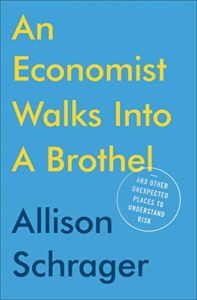An Economist Walks Into a Brothel
And Other Unexpected Places to Understand Risk
Author: Allison Schrager

No available rating

No available rating

PROJECTMANAGEMENT.CO QUICK REVIEW
This is a sample place holder
GetAbstract Summary Preview
No Risk, No Reward
Understanding that risk is inevitable in any choice is Schrager’s first rule of risk management. Where most people fail in this area is either by underestimating the level of risk, or ignoring it altogether. Measuring the type and amount of risk in advance helps you to decide whether the reward is ultimately worth it.
Irrationality
In an interview with World Poker Champion Phil Hellmuth, Schrager highlights the role that emotions can play in our assessment of risk. By his own admission, Hellmuth is emotional and irrational––he didn’t get the title Poker Brat by chance. However, he succeeds by recognizing these impulses and learning to channel them into outrageous behavior at the poker table rather than poor decision making at the turn of a card.
Getting The Biggest Bang for Your Risk Buck
Diversification is more efficient because it minimizes risk. The author switches gears to the technological advancements in horse breeding after the sequencing of the horse genome in 2009 to illustrate the payoff in careful management of bloodstock.
Be The Master of Your Domain
Schrager offers two mechanisms to control your risk exposure––hedging and insurance. Hedging we covered in the legal brothels in Vegas. Insurance, as the author points out, is magic. In return for a premium, insurers take on your downside risk––whether it’s a model’s legs, Dolly Parton’s most famous assets, or a crab fisherman’s ability to fish.
“Rule 5”
Preparation for the “unknown unknowns” that former Defense Secretary Donald Rumsfeld made famous in the Bush 43 Presidency, allows you to incorporate the irrational human element in any decision. In other words, after you build your complex risk assessment, question every assumption, challenge each and every anticipated outcome, and then go back one more time and ask: “What if we’re completely wrong?” An Economist Walks into a Brothel argues that risk can be managed or mitigated, but it should never be ignored. Using a diverse range of examples from her field research, Allison Schrager offers five simple but powerful rules to manage the risk element of any successful initiative.
About The Author & Review
About The Author:
In An Economist Walks into a Brothel, Schrager equips readers with five principles for dealing with risk, principles used by some of the world’s most interesting risk takers. For instance, she interviews a professional poker player about how to stay rational when the stakes are high, a paparazzo in Manhattan about how to spot different kinds of risk, and horse breeders in Kentucky about how to diversify risk and minimize losses. When you start to look at risky decisions through Schrager’s new framework, you can increase the upside to any situation and better mitigate the downside.
Review:
The word risk should accompany any decision or action to reflect the relative probability of an alternate outcome to the one anticipated. Typically, that alternative outcome is expected to be negative––loss, damage, injury, or liability.
In her new book An Economist Walks into a Brothel: And Other Unexpected Places to Understand Risk, Ph.D. economist Allison Schrager reminds us that risk is an inherent part of change, and that even the most cautious among us take risks every day. The difference between success and failure lies in how we manage that risk, and Schrager offers five rules to help us do that.
The playful title carries a serious message––the commerce of brothels carries high personal risk for both buyers and sellers. Visiting four legal brothels in Nevada as part of the field research for the book, the author finds that the girls were willing to hand over fifty percent of their earnings to the management company for full security protection. In financial terms, they are hedging––giving-up potential earnings in return for risk reduction.

